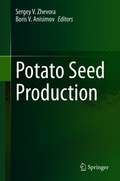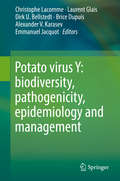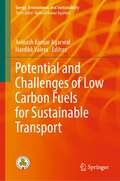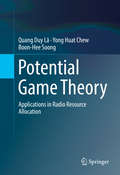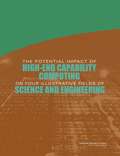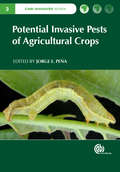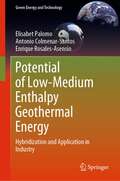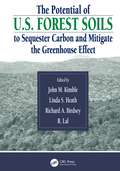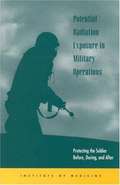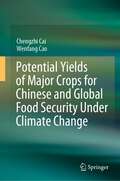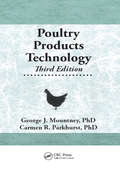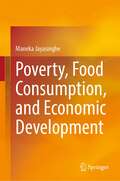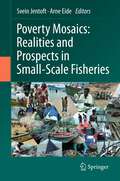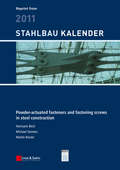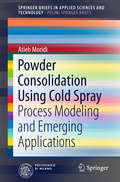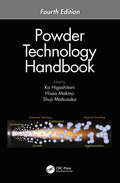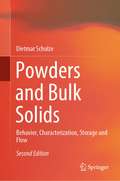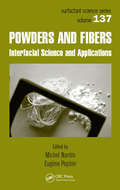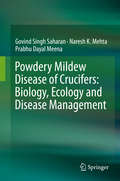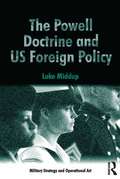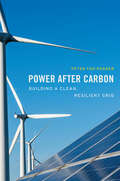- Table View
- List View
Potato Seed Production
by Sergey V. Zhevora Boris V. AnisimovThis book comprises the best potato seed production practices and includes details on potato cultivation, classification, and the main structural elements of the successive stages of potato seed production. It presents potato varieties from Russian originators, describes modern technologies involved in the process of potato seed production, and presents special aspects of phytosanitary and process regulations for the cultivation of high-quality potato seed.Additionally, the authors illustrate the statutory regulation of salable quality of potato seed: purity of variety, diseases, pests, and defects. The authors identify Russian quality control methods and certification of potato seed, and consider the packaging and labeling of potato seed that is held for sale. Finally, the authors also clarify the features of foreign potato seed certification systems.
Potato virus Y: biodiversity, pathogenicity, epidemiology and management
by Christophe Lacomme Laurent Glais Dirk U. Bellstedt Brice Dupuis Alexander V. Karasev Emmanuel JacquotPotato virus Y (PVY) infects a wide host range mainly within the Solanaceae and is distributed worldwide. PVY is transmitted by more than 40 aphid species in a non persistent manner. Isolates of the PVY species are highly variable at biological, serological and molecular levels. Epidemiological studies have highlighted the emergence of distinct potato PVY variants able to induce necroses on potato tubers. Due to the lack of efficient resistance to PVY isolates inducing necrotic symptoms in cultivated varieties and the plant-to-plant transmission of isolates through the daughter tubers, PVY has become the most economically important virus for the potato industry. The review offers an overview of several decades of research on PVY but also focuses on the latest data obtained by expert on PVY worldwide on the biological characteristics of PVY, interactions between aphids-hosts, its evolution and management. Identified knowledge gaps to understand further PVY biology will be discussed.
Potential and Challenges of Low Carbon Fuels for Sustainable Transport (Energy, Environment, and Sustainability)
by Avinash Kumar Agarwal Hardikk ValeraThis book focuses on low carbon fuels a preferable class of fuels for Internal Combustion Engines (ICEs) highlighting the effect of low carbon fuels on tailpipe emissions. This book aims to strengthen the knowledge base dealing with low carbon fuels as a sustainable transport fuel. The volume includes recent results and are focused on current trends of automotive sector. This book will be of interest to those in academia and industry involved in fuels, IC engines, engine instrumentation, and environmental research.
Potential Game Theory
by Quang Duy Lã Yong Huat Chew Boon-Hee SoongThis book offers a thorough examination of potential game theory and its applications in radio resource management for wireless communications systems and networking. The book addresses two major research goals: how to identify a given game as a potential game, and how to design the utility functions and the potential functions with certain special properties in order to formulate a potential game. After proposing a unifying mathematical framework for the identification of potential games, the text surveys existing applications of this technique within wireless communications and networking problems found in OFDMA 3G/4G/WiFi networks, as well as next-generation systems such as cognitive radios and dynamic spectrum access networks. Professionals interested in understanding the theoretical aspect of this specialized field will find Potential Game Theory a valuable resource, as will advanced-level engineering students. It paves the way for extensive and rigorous research exploration on a topic whose capacity for practical applications is vast but not yet fully exploited.
The Potential Impact Of High-end Capability Computing On Four Illustrative Fields Of Science And Engineering
by National Research Council of the National AcademiesMany federal funding requests for more advanced computer resources assume implicitly that greater computing power creates opportunities for advancement in science and engineering. This has often been a good assumption. Given stringent pressures on the federal budget, the White House Office of Management and Budget (OMB) and Office of Science and Technology Policy (OSTP) are seeking an improved approach to the formulation and review of requests from the agencies for new computing funds. This book examines, for four illustrative fields of science and engineering, how one can start with an understanding of their major challenges and discern how progress against those challenges depends on high-end capability computing (HECC). The four fields covered are: atmospheric science astrophysics chemical separations evolutionary biology. This book finds that all four of these fields are critically dependent on HECC, but in different ways. The book characterizes the components that combine to enable new advances in computational science and engineering and identifies aspects that apply to multiple fields.
Potential Invasive Pests of Agricultural Crops
by Jose Romeno Faleiro Alvaro Castañeda Vildózola Robert Haack Crebio Avila Jose Roberto Parra Mark Hoddle Alberto Urbaneja Ana Diaz Montilla Juli Gould Andrea Birke Aldo Malavasi V Satarkar Raymond Gagne Juliet Goldsmith J. Ramon Valiente Jose Carlos Rodrigues Cal Welbourn Denise Navia Amy Roda Mark Culik J Alvarez Takumasa Kondo Gregory Evans Kenneth Storey Michael Hennessey David Bartels Anne Roy Ana Isabel Gonzalez Greg HodgesInvasive arthropods cause significant damage in agricultural crops and natural environments across the globe. Potentially threatened regions need to be prepared to prevent new pests from becoming established. Therefore, information on pest identity, host range, geographical distribution, biology, tools for detection and identification are all essential to researchers and regulatory personnel. This book focuses on the most recent invasive pests of agricultural crops in temperate subtropical and tropical areas and on potential invaders, discussing their spread, biology and control.
Potential Invasive Pests of Agricultural Crops
by V Satarkar Jose Carlos Rodrigues Crebio Avila J Alvarez Andrea Birke Jorge Peña Jose Roberto Parra Denise Navia Juliet Goldsmith Anne Roy Takumasa Kondo Kenneth Storey Aldo Malavasi Amy Roda J. Ramon Valiente Mark Culik Ana Isabel Gonzalez Michael Hennessey Jose Romeno Faleiro Greg Hodges Juli Gould Alvaro Castañeda Vildózola Gregory Evans Cal Welbourn Mark Hoddle David Bartels Alberto Urbaneja Ana Diaz Montilla Robert Haack Raymond GagneInvasive arthropods cause significant damage in agricultural crops and natural environments across the globe. Potentially threatened regions need to be prepared to prevent new pests from becoming established. Therefore, information on pest identity, host range, geographical distribution, biology, tools for detection and identification are all essential to researchers and regulatory personnel. This book focuses on the most recent invasive pests of agricultural crops in temperate subtropical and tropical areas and on potential invaders, discussing their spread, biology and control.
Potential of Low-Medium Enthalpy Geothermal Energy: Hybridization and Application in Industry (Green Energy and Technology)
by Elisabet Palomo Antonio Colmenar-Santos Enrique Rosales-AsensioThis book highlights the importance of geothermal energy by studying its potential either alone or in combination with solar energy, focusing on its industrial application. Its starting point is to identify in a thorough and precise manner the barriers that hinder the implementation of geothermal energy in Spain and the European Union and the measures to be taken to achieve its diffusion and regular use. Next, the book looks at how geothermal energy could contribute to this sector and to the desalination industry in particular, analysing a specific case in the south of Spain and extrapolating its results to a set of existing desalination plants in the Spanish Mediterranean with really interesting results in terms of economic amortisation and CO2 emissions avoided to the atmosphere. Beyond the desalination industry, this work demonstrates that almost 85% of the industrial processes of all industry in Spain can be carried out with very low, low and medium temperature geothermal resources and even applies its results to a set of existing solar plants, comparing in economic terms the results already obtained with those that would have been obtained if geothermal energy had been applied.
The Potential of U.S. Forest Soils to Sequester Carbon and Mitigate the Greenhouse Effect
by John M. Kimble Rattan Lal Richard Birdsey Linda S. HeathMuch attention has been given to above ground biomass and its potential as a carbon sink, but in a mature forest ecosystem 40 to 60 percent of the stored carbon is below ground. As increasing numbers of forests are managed in a wide diversity of climates and soils, the importance of forest soils as a potential carbon sink grows. The Potenti
Potential Radiation Exposure in Military Operations: Protecting the Soldier Before, During, and After
by Institute of MedicineThe Committee's final report, reiterating technical aspects addressed in a 1997 interim report, and putting the research findings in an ethical context. The report focuses on the potential exposure of military personnel to radiation doses up to 700 millisievert, examining dosimetry, radiation physics, and the medical follow-up of potential subsequent tumor development. There is no index. Annotation c. Book News, Inc. , Portland, OR (booknews. com)
Potential Therapeutic Applications of Nano-antioxidants
by Sharda Sundaram Sanjay Ashutosh Kumar ShuklaThis book highlights the nano-antioxidants and their potential therapeutic applications. The chapters start with basic information on free radicals and antioxidants, through natural antioxidants, mechanisms of their action, ending with the use of nano-antioxidants particularly its potential therapeutic applications. Nano-antioxidant therapy has a promising future that has to be explored. It is a bridge topic to connect the already existing literature with potential therapeutic highlights. This book is designated for students and researchers interested in Biochemistry, Chemistry, Physics, Food Science and nutrition, Pharmaceutical Science and Medicine. It would also be interesting to global audiences from human and animal nutrition to food preservation and packaging.
Potential Yields of Major Crops for Chinese and Global Food Security Under Climate Change
by Chengzhi Cai Wenfang CaoThis book analyzes potential yields of six major food crops - rice, wheat, maize, potato, soybean and rapeseed worldwide using both qualitative and quantitative approaches to study both China’s and global food security under climate change. Firstly, it reviews previous studies on potential yields of rice, wheat, maize, potato, soybean and rapeseed worldwide to provide a detailed information of studying on China’s and global food security based on the product’s supply and demand of these crops. Secondly, average and top (national) yields of rice, wheat, maize, potato, soybean and rapeseed since 1961 on global scale are employed to analyze their temporal and spatial variation trends and potential limits. Thirdly, the effects of global warming in climate change on both average and top yields of rice, wheat, maize, potato, soybean and rapeseed since 1961 at global level are analyzed using regression model, and their differences between average and top yields among these crops are identified and compared. Fourthly, the yields and per capita quantity of rice, wheat, maize, potato, soybean and rapeseed in major producer-countries and the world are analyzed to assess the situation and trend of international trade for the products of these crops, respectively.Fifthly, potential yields of rice, wheat, maize, potato, soybean and rapeseed worldwide by 2030 are projected using both trend-regressed models and ARIMA models to estimate the per capita quantity of these crops based on the projection of world population and assess the status of Chinese and global food security in that future. Finally, it provides policy implications and advice on food security for China and the world directing food production by 2030 under climate change.
Pottsville Firefighting (Images of America)
by Michael R. Glore Michael J. KitsockIn 1829, the Humane Hose Company and the Schuylkill Hydraulians Engine Company organized in the booming town of Pottsville, a mining center in Pennsylvania's anthracite coal region. Fire protection was urgently needed for this growing community. New fire companies such as the Good Intent, the Rough and Ready, and the Good Will formed, as well as junior fire companies, including the Rangers and the Young America. In a patriotic response to President Lincoln's call to arms, two Pottsville fire companies disbanded, committing themselves to the Union; they became members of the legendary "First Defenders" of the Civil War. The twentieth century brought new challenges of motorization, dieselization, and ever-stricter training standards. Pottsville Firefighting celebrates one hundred seventy-five years of firefighting in Pottsville.
Poultry Breeds: Chickens, Ducks, Geese, Turkeys: The Pocket Guide to 104 Essential Breeds
by Carol EkariusPoultry Breeds is a fresh field guide of feathered friends with stunning photos highlighting the beauty and unique attributes of 104 chicken, duck, goose, and turkey breeds. Each profile outlines the bird’s history, physical characteristics, and common uses, with specially noted fun facts sprinkled throughout. This pocket-size, browsable guide is easy to use, and author Carol Ekarius knows her birds: she has been writing about livestock for nearly 20 years and has raised her own for decades.
Poultry Products Technology: Third Edition
by VivianE MountneyNow in its third edition, this classic volume characterizes the science and technology of the poultry industry today, defines the breadth and scope of the overall problems in the industry, and points out areas where more research is needed. With special attention to recent changes in the industry, the nearly two dozen updated chapters of Poultry Products Technology provide a comprehensive overview of the field, examining topics which deal with the processing, handling, marketing, and preparation of poultry meat, products, and by-products.Poultry Products Technology provides up-to-date information and references for food scientists, food technologists, dieticians, and others trained in the food service industry, who will at some point handle poultry products. This book supplies knowledge about how poultry and eggs are processed and prepared and how they can be used for optimum portions and services. The breadth of topics covered, as listed below, make it an ideal text for those just entering the field, for individuals who wish to learn about the work in a particular area before starting extensive research, and for those in the industry who require specific information for making decisions and projecting plans for the future:quality identification--grades and standardsquality maintenance--handling and processing poultry and eggs to prevent grade losseschemical and nutritive characteristics of poultry meat and eggsmicrobiology of eggs and poultry meatmethods of preservation--freezing, drying, refrigeration, radiation, canning, smokingcooking poultry meat and eggshandling and uses of inedible by-productsmethods of analysis of eggs and egg productsDuring the last twenty years, the consumption of poultry meat has and continues to increase while the consumption of eggs has steadily decreased, yet both are still considered good econ
Poverty, Food Consumption, and Economic Development
by Maneka JayasingheThis book investigates the relationships between economies of scale in food consumption and a number of socio-economic and demographic characteristics of households and household behavioural choices since food is the major share of household expenditure for poor households. The characteristics considered comprise household size, location, income, and gender of the head of household while the behavioural choices considered comprise the decision to consume home-grown food and the decision to adopt domestic technology to aid food preparation and consumption. The book proposes two theoretical models to rationalize the role of the consumption of home-grown food and the adoption of domestic technology in enhancing economies of scale in food consumption. Econometric models are also used to empirically test the validity of the two theoretical models while adjusted poverty estimations are derived numerically using the estimated equivalence scales. Although data used in applying these techniques are based on four Household Income and Expenditure Surveys conducted by the Department of Census and Statistics (DCS) in Sri Lanka, the methodology can be used for similar analysis in relation to any other country.
Poverty Mosaics: Realities and Prospects in Small-Scale Fisheries
by Svein Jentoft Arne EideSmall-scale fisheries are a major source of food and employment around the world. Yet, many small-scale fishers work in conditions that are neither safe nor secure. Millions of them are poor, and often they are socially and politically marginalized. Macro-economic and institutional mechanisms are essential to address these poverty and vulnerability problems; however, interventions at the local community level are also necessary. This requires deep understanding of what poverty means to the fishers, their families and communities; how they cope with it; and the challenges they face to increase resiliency and improve their lives for the better. This book provides a global perspective, situating small-scale fisheries within the broad academic discourse on poverty, fisheries management and development. In-depth case studies from fifteen countries in Latin America, Europe, South and Southeast Asia, and sub-Saharan Africa, demonstrate the enormously complex ecological, economic, social, cultural and political contexts of this sector. Conclusions for policy-making, formulated as a joint statement by the authors, argue that fisheries development, poverty alleviation, and resource management must be integrated within a comprehensive governance approach that also looks beyond fisheries. The scientific editors, Svein Jentoft and Arne Eide, are both with the Norwegian College of Fishery Science, Faculty of Biosciences, Fisheries and Economics, University of Tromsø, Norway.
Powder-actuated Fasteners and Fastening Screws in Steel Construction
by Hermann Beck Michael Siemers Martin ReuterAn overview of fastening techniques, technology and applicationsThis book covers fastening screw technology, verification concepts, applications in steel construction and other chapter topics. Powder-actuated Fasteners and Fastening Screws in Steel Construction introduces the basic principles and methods of using fastening screws in steel construction. Illustrations aid readers in understanding the features and characteristics of the screws. The powder-actuated fastening technique is described as is fastening screw technology and its applications.
Powder Consolidation Using Cold Spray
by Atieh MoridiThis book first presents different approaches to modeling of the cold spray process with the aim of extending current understanding of its fundamental principles and then describes emerging applications of cold spray. In the coverage of modeling, careful attention is devoted to the assessment of critical and erosion velocities. In order to reveal the phenomenological characteristics of interface bonding, severe, localized plastic deformation and material jet formation are studied. Detailed consideration is also given to the effect of macroscopic defects such as interparticle boundaries and subsequent splat boundary cracking on the mechanical behavior of cold spray coatings. The discussion of applications focuses in particular on the repair of damaged parts and additive manufacturing in various disciplines from aerospace to biomedical engineering. Key aspects include a systematic study of defect shape and the ability of cold spray to fill the defect, examination of the fatigue behavior of coatings for structural applications, and a novel working window at subcritical conditions to obtain porous structures. This book is exceptional in scope, and its review of finite element modelling at different length scales sheds light on future design and process improvement in emerging applications such as structural repair, metal additive manufacturing and metal foam design.
Powder Technology Handbook
by Ko Higashitani Hisao Makino Shuji MatsusakaThe Fourth Edition of Powder Technology Handbook continues to serve as the comprehensive guide to powder technology and the fundamental engineering processes of particulate technology, while incorporating significant advances in the field in the decade since publication of the previous edition. The handbook offers a well-rounded perspective on powder technologies in gas and liquid phases that extends from particles and powders to powder beds and from basic problems to actual applications. This new edition features fully updated and new chapters written by a team of internationally distinguished contributors. All content has been updated and new sections added on. Powder Technology Handbook provides methodologies of powder and particle handling technology essential to scientific researchers and practical industrial engineers. It contains contemporary and comprehensive information on powder and particle handling technology that is extremely useful not only to newcomers but also to experienced engineers and researchers in the field of powder and particle science and technology.
Powders and Bulk Solids: Behavior, Characterization, Storage and Flow
by Dietmar SchulzeThe book concentrates on powder flow properties, their measurement and applications. These topics are explained starting from the interactions between individual particles up to the design of silos. A wide range of problems are discussed – such as flow obstructions, segregation, and vibrations. The goal is to provide a deeper understanding of the powder flow, and to show practical solutions.
Powders and Fibers: Interfacial Science and Applications (Surfactant Science #137)
by Michel Nardin Eugène PapirerNew analytical methods have provided further insight into the structure, surface characteristics, and chemistries of increasingly small particles. However, current literature offers information on only a limited number of powders being investigated. Written by renowned scientists in the field, Powders and Fibers: Interfacial Science and Application
Powdery Mildew Disease of Crucifers: Biology, Ecology and Disease Management
by Govind Singh Saharan Prabhu Dayal Meena Naresh K. MehtaPowdery mildew disease is the fourth most widespread disease in cruciferous crops and a devastating effect, causing significant losses in terms of quality and quantity in rapeseed and mustard. Powdery mildews are also a favourable host-pathosystem model for basic research on host–parasite interactions, developmental morphology, cytology, and molecular biology to identify the effector proteins/genes governing different biological functions. This book provides a comprehensive overview of all the published information in the field for researchers, teachers, students, extension experts, industrialists and farmers, and includes illustrations, photographs, graphs, figures, tables, histograms, micrographs, electron micrographs, and flow charts to aid understanding. It also describes standardized reducible techniques. The book discusses each disease in detail, describing the distribution, symptomatology, host range, yield losses and disease assessment, as well as the taxonomy, morphology, phylogeny, variability, sporulation, survival and perpetuation of the pathogen. Further, it explores topics such as spore germination; infection; pathogenesis; disease cycle; epidemiology; forecasting; fine structures; host resistance; biochemical, histological, genetic and molecular aspects such as cloning and mapping of R genes; sources of resistance; disease resistance breeding; and the genetics of host-parasite interactions and disease management.
The Powell Doctrine and US Foreign Policy (Military Strategy and Operational Art)
by Luke MiddupThe Vietnam War is one of the longest and most controversial in US history. This book seeks to explore what lessons the US military took from that conflict as to how and when it was appropriate for the United States to use the enormous military force at its disposal and how these lessons have come to influence and shape US foreign policy in subsequent decades. In particular this book will focus on the evolution of the so called ’Powell Doctrine’ and the intellectual climate that lead to it. The book will do this by examining a series of case studies from the mid-1970s to the present war in Afghanistan.
Power after Carbon: Building a Clean, Resilient Grid
by Peter Fox-PennerAs the electric power industry faces the challenges of climate change, technological disruption, new market imperatives, and changing policies, a renowned energy expert offers a roadmap to the future of this essential sector. As the damaging and costly impacts of climate change increase, the rapid development of sustainable energy has taken on great urgency. The electricity industry has responded with necessary but wrenching shifts toward renewables, even as it faces unprecedented challenges and disruption brought on by new technologies, new competitors, and policy changes. The result is a collision course between a grid that must provide abundant, secure, flexible, and affordable power, and an industry facing enormous demands for power and rapid, systemic change. The fashionable solution is to think small: smart buildings, small-scale renewables, and locally distributed green energy. But Peter Fox-Penner makes clear that these will not be enough to meet our increasing needs for electricity. He points instead to the indispensability of large power systems, battery storage, and scalable carbon-free power technologies, along with the grids and markets that will integrate them. The electric power industry and its regulators will have to provide all of these, even as they grapple with changing business models for local electric utilities, political instability, and technological change. Power after Carbon makes sense of all the moving parts, providing actionable recommendations for anyone involved with or relying on the electric power system.
